Instruments
|
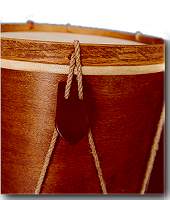
TABORS
Today’s Tabors
- A multiplicity of names in the contemporary pipe-and-tabor
tradition
The word "tabor" is simply an English variant of a Latin-derived word
meaning "drum" - cf. tambour (Fr.), tamburo (It.), .... As used
today, it refers to the drum used by the players of the Pipe-and-Tabor combination.
The tabor has a cylindrical shell, two heads tightened by ropes, and one snare - usually
doubled back so as to provide two strands. It is played by just one stick, which usually
strikes the snare head. The tabor is suspended by a strap from the forearm, somewhere
between the elbow and wrist. When played, the shell is virtually parallel with the ground.
Today’s tabors range in size from the small 3"x3" Catalan tamboril
to the large tambourin Provenšale, which can measure as much as 30"
high and 16" diameter.
The Pipe-and-Tabor had its beginnings over a eight hundred years ago and has
been played, at one time or another, in every area of Western Europe. It exists today as a
continuous and vibrant tradition in the Provenše area of southern France, the Basque area
in the Pyrenees Mountains straddling Spain and France, the Catalan region of northern
Spain, and elsewhere in the Iberian peninsula. In modern times, the playing of
pipe-and-tabor has been revived for Morris and Country dancing in England and the U.S.
Players are also found in Latin America, a legacy of the Colonial era. The repertoire is
substantial, ranging from catchy dance music to beautiful ballads from all periods of
music history.
Throughout its history the tabors accompanying the pipe have come in many different
sizes (pipes have also come in many different sizes and intonations). There is even a
stringed instrument, the tambourin de BÚarn (struck by a stick), which serves as a
tabor; an illumination in the Cantigas manuscript (13c) shows a pipe player
accompanying himself by ringing a bell . What follows is a description of tabors found in
the main folk traditions of present-day Europe. The three most frequently encountered
tabors today are the Basque, English Country, and tambourin provenšale.
These are among the five sizes offered by Harms Historical Percussion.
Tabor shells are generally thin, making them light in weight and allowing the player to
carry them for long periods of time without tiring the arm. Because of the thinness of the
shell and the inherent flexibility of the skin heads, the tone is more resonant and
lower-pitched than other drums of similar size which might be found in the concert hall,
on the marching field, or at the jazz drumset. Due to their thinness, most tabors do not
sound very good when placed on a metal drum stand or other solid surface: the vibrations
get absorbed or muffled. Tabors need to be suspended. They should not be struck with
excessive force.
Terminology:
There are four principal types of tabor found in present-day
European folk traditions. The same instrument can often go by several different names.
Conversely, the same word (e.g., tamboril), can refer to one of several
instruments: one must be certain of the area from which it comes. |
Provenše,
Southern France
 |
Tambourin. The tambourin, or tambourin provenšale, is the
largest of all the tabors, standing 24-30" high, and with a diameter of 14-16".
The skins are thin calf on the snare side (which is the side that is struck) and goat on
the other. The stick, or massetto, can be up to 16" long is made of
three different materials glued together. A thin wooden shank ends with a tip made of
ivory or bone. The butt end is made of hard wood and is shaped like an egg. The tambourin
should ideally be tuned to the dominant of the key of the musical piece being played.
Instruction books stress that it should not sound like a military drum. The sound
should instead evoke that made by the evening locust (Fr. cigale), the
loosely-tensioned snare providing the "buzz" of the locust. The rhythms played
can be quite complex, especially considering the fact that the player is playing the pipe
- with different rhythms, of course - at the same time.
The pipe is called a galoubet; the player of the Pipe-and-Tabor
combination is called a tambourinaire. There is an extensive folk literature as
well as many compositions written for the tambourinaire. Henri Tomasi’s Tombeau
de Mireille..., is often performed on piccolo and snare drum, but was actually written
for a 13-year-old tambourinaire. The 18th century Paris Opera orchestra had a
permanent position for a tambourinaire, due to the large number of pastoral scenes
which were included in the operas (also for entertainment at intermission, when possible).
This tradition followed well into the 19th century.
The tambourin is the instrument which is probably of most interest to the
professional percussionist because it is the instrument specified by Bizet in the
"Farandole" of his L’Arlesienne Suite. The melody - of folk origin -
appears on p. 246 of F. Vidal’s book Lou tambourin, (Arles, 1862)
with the title "Danso dei Chivau-Frus". |
Basque country
and Navarre
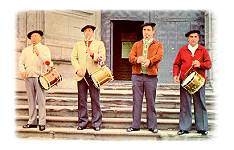 |
A.Tamboril, tun-tun , arratza. This tabor measures
10"x10" . The pipe is called a txistu (pronounced "chee-stu"),
and the player is called a txistulari (in Navarre, a "chunchunerua"). In
the Basque Country, as in Provenše, the txistulari is the most
frequently-encountered folk musician.
B. Tambor, atabal, or atabalero. One thing which is unique
to the Basque tradition is that there can be ensembles as well as soloists. Two txistularis
can play duets. A four-member ensemble consists of two txistularis and two
specialists: one plays a type of bass pipe (no tabor), while the other plays with two
sticks on a type of small field drum (approx. 6"x12.5") called variously a
tambor, atabal, or atabalero. |
Catalonia.
NE Spain
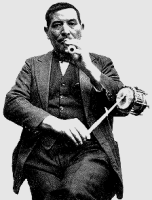 |
Tamboril, tambor, tambori: This is smallest of all the tabors, measuring
only 3"x3". The shell can be made of wood or metal, and the stick is short. The
Pipe-and-tabor player in Catalonia is part of a unique "cobla" dance band,
consisting of 10-11 players, which plays chiefly the Sardana, a local round dance.
He plays an introduction on the pipe (called variously a flabiol, flaviol, or flubiol),
then hits the drum and proceeds to provide the beat for the dance, which can last anywhere
from 5 to 45 minutes. While the dancing proceeds, he will occasionally double the melody
or even play solos on the pipe.
There is little subtlety involved in tamboril playing (the beat is a constant quarter-eighth-eighth)
though it must of course be steady, since it keeps the beat for the band. It is held by a
strap that goes through two hoops mounted on the shell. The strap is then placed around
the neck and stretched by the forearm, which pushes against the drum, pulling the strap
taut. |
England
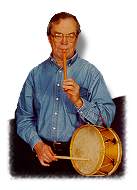 |
Tabor, "English Country" Tabor: The most common
size of the English tabor is about 4-5" high and 10" diameter. This is the shape
shown in Praetorius’ Syntagma Musicum (1617: the precise measurements are not
possible to determine), which he describes as being used "by the English".
Historically, tabors of many different dimensions were used by the English - none as large
as the tambourin - and that is still true today. |
Various locations
in France and Spain
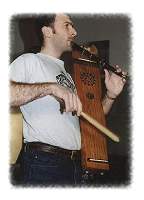 |
Tambourin de BÚarn, tanburia, salterio, ttun-ttun, txun-txun: Found
infrequently along the border of France & Spain. This is a tabor only in the sense
that it is struck rhythmically with a stick. The instrument actually resembles a psaltery
or lyre, having 3-6 strings - tuned to the tonic and dominant - stretched over a
resonating box, something like a guitar or ukelele without a fingerboard. Photo at left is
of Basque musician, Sabin Bikandi. |
Tabor Pipes

|
Some of the taborpipes in use today: From Left to Right:
Balearic Islands (Majorca, Minorca), Provenše, Basque Country, England, Catalonia. The
drumstick is 14” (31cm) long. |
Differences between a tabor and a field drum:
The main differences are:
- Size: With the exception of the tambourin Provenšale, the field drum has
a greater diameter and depth.
- Number of sticks used: the field drum is played with two sticks, tabor with one.
- Skin tension: the field drum is played with the skins stretched much tighter.
- Snares: there are just 1-2 lengths of snare on the tabor, while modern field
drums have many more. (It should be noted, however, that field drums in the 17th century -
perhaps even later - only had 2 snares. If they are tensioned properly, no more are
needed.)
- Manner carried: field drum with sling over the shoulder; tabor suspended from
arm.
The "fife-and-drum" vs. the
"pipe-and-tabor":
The sound of the both these combinations - a high-pitched whistle accompanied by drum
rhythms at a lower pitch level - is remarkably similar. When played outdoors, they both
carry well over large distances.
An obvious difference is the number of players needed: the pipe-and-tabor player is a
one-man-band, while the fife-and-drum requires two different players. The most significant
difference, though, is in the type of music played: The fife and (field) drum is used for
military and ceremonial purposes. The pipe-and-tabor is used for social functions -
dancing, weddings, and other gentler pursuits.
Shakespeare illustrates this difference in Much Ado About
Nothing, Act II, sc. 3, where the speaker is reflecting on the change that has
come over a friend of his who has fallen in love:
"...I have known when there was no music for him but
the drum and the fife; and now he had rather hear the tabor and the pipe."
|
 HARMS HISTORICAL PERCUSSION
HARMS HISTORICAL PERCUSSION